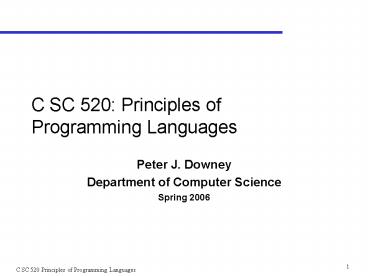C SC 520: Principles of Programming Languages - PowerPoint PPT Presentation
Title:
C SC 520: Principles of Programming Languages
Description:
Specification of a virtual computer. C SC 520 Principles of Programming Languages. 4 ... semantic specification. Denotational specification using syntax ... – PowerPoint PPT presentation
Number of Views:23
Avg rating:3.0/5.0
Title: C SC 520: Principles of Programming Languages
1
C SC 520 Principles ofProgramming Languages
- Peter J. Downey
- Department of Computer Science
- Spring 2006
2
Principles of ProgrammingLanguages
- Lecture 01
- Introduction
3
A Programming Language
- Notation for describing algorithms and data
structures - Medium for communicating procedural actions to an
interpreting agent (machine or man) - Mental tool for
- Solving procedural problems
- Representing algorithms
- Reasoning about algorithms
- Specification of a virtual computer
4
Reasons to study programming languages
- To understand the connection between languages
and the problem solving processhow it conditions
our thinking - To suggest designs for languages suited to needs
of problem solving and software productionthe
isolation of universals - To permit a better choice of programming language
for a particular problem - To understand the meaning of one language by
comparison with othersdevelopment of semantic
description tools - To understand how languages and features are
implemented - To make it easier to learn new languages
5
Semiotics
the study of signs and systems of signs
Syntax
--C.W. Morris, Foundations of the Theory of
Signs, Int. Encyc. of Unified Science, Ser.
I, Vol. 2, U of Chicago Press, 1938.
sign (or name) --formal
Semantics
Pragmatics
interpreter (or agent) --operational
object (or referent) --ideal
- Syntactics relations between signs (in
abstraction from their associations with objects
or interpreters) - Semantics relations between signs and objects
they denote the study of sign meaning, including
relations among objects denoted - Pragmatics nature of sign-interpreters and the
origin, uses and effects of signs on interpreters
6
Ex The Language Binary Numerals
- Syntax signs
- Numerals (syntactic category ltnumgt)
- Abstract syntax
- ltnumgt ltnumgt 0 ltnumgt 1 0 1
- Semantics sign ? object
- A mapping (semantic map) from numerals
to integers - Defined by syntax-driven (compositional)
semantics - meta-variable N ranges over elements of the
syntactic category ltnumgt
7
Binary Numerals (cont.)
- Another semantic notion is semantic
equivalence ? - 101 ? 0101 since
- Pragmatics interpreter ? object
- Design of an interpreter to check ?
- Algorithm Add to perform semantically valid
addition of symbols
8
Ex C
- Syntax
- C grammar
- C parser
- Semantics
- Axiomatic semantic specification
- Denotational specification using syntax-directed
(compositional) rules - Pragmatics
- Implementation techniques
- Programming methodology given Cs features
9
Reasons for Semantic Description
- Main aim each phrase of language is given a
denotation (meaning, referent) determined only by
the meaning of its subphrases - Benefits
- Standard of definition
- Basis for design comparisons
- Basis for correctness, validation
- Provides insight
- Methods
- Informal semantics (e.g., Algol 60) incomplete,
even inconsistent - Operational semantics (e.g., standard
implementation) it is what it doesmeaning and
pragmatics confused - Axiomatic semantics meaning of phrase is a
predicate transformation. Directly supports
verification - Denotational semantics every phrase denotes a
thing (integer, boolean, mathematical function)































